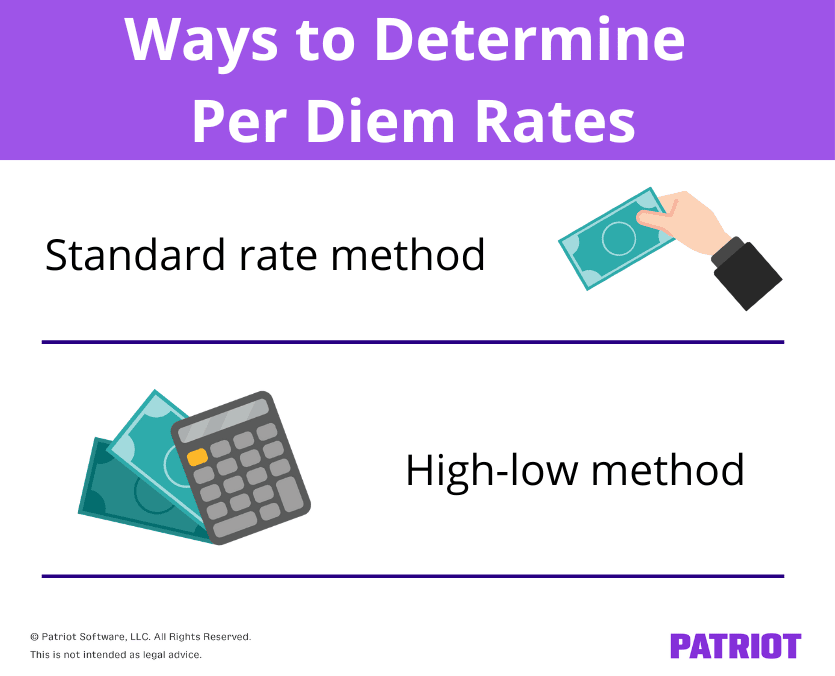This article has been updated to reflect 2022 rates.
When your employees travel for work, you might consider covering some of their travel-related expenses. To do this, you can offer per diem pay.
You have a couple of options when it comes to reimbursing employees for business travel costs. Read on to learn about the IRS per diem rates and when and how to use the different rates.
What are the IRS per diem rates?
Before we dive into the current IRS per diem rates, you need to answer the question, What is per diem?
Per diem is a daily allowance you give employees for travel-related expenses. With per diem pay, you give employees a fixed dollar amount to cover things like lodging, meals, and incidental expenses (e.g., tips for employees). In some cases, per diem might be limited to just covering meals and incidental expenses (M&IE). You cannot give employees per diem pay to cover transportation expenses or mileage reimbursement.
You can provide per diem in advance before your employees travel for business. Or, you can reimburse them after the business trip.
You are not required to offer per diem to employees. However, per diem pay gives employees the chance to travel for business without paying for expenses out of pocket.
Government per diem rates change year to year depending on IRS Publication 1542. Rates are updated each year and go into effect on October 1. The General Services Administration (GSA) provides current, past, and upcoming national per diem rates.
Rates can vary by location and usually increase in more expensive parts of the country, such as big cities (e.g., New York City).
There are two ways you can determine per diem rates, including the:
- Standard per diem rate method
- High-low method

Standard per diem rate method
The standard per diem rate method changes based on the locality you send the employee. If your employee is traveling within the Continental United States (CONUS), the GSA provides per diem rates for certain cities.
The 2023 standard per diem rate is $157 per day. This includes $98 for lodging and $59 for meals and incidental expenses. The rate of $155 covers approximately 2,600 counties across CONUS.
On the first and last day of an employee’s travel, you only need to pay 75% of the standard rate for M&IE.
Check out the GSA’s website for more information about standard rates.
High-low per diem method
In addition to the standard rate method, the IRS also allows you to use a high-low method.
The high-low per diem method uses one rate for high-cost localities and another for other cities in CONUS that are not considered high-cost.
Rates for the high-low method change each year. Look out for new high-low rates annually.
As of 12023, high-low rates include:
- $297 per day (including $74 for M&IE) for high-cost localities
- $204 per day (including $64 for M&IE) for CONUS cities
Use the rate of $297 per day if an employee is traveling to a high-cost area, like New York City. You can review Notice 2021-52 for other cities that are considered to be high-cost.
If the locality is not high-cost, use the rate of $204 per day for CONUS cities.
Per diem rates in action
As an employer, the idea of federal per diem rates can be confusing. To clear up some confusion, check out examples of the two IRS per diem methods below.
Standard rate example
Again, the standard per diem rate is $157 ($98 for lodging and $59 for meals and incidental expenses). Keep in mind that you only have to pay 75% of the standard rate on the employee’s first and last day of travel for M&IE.
Say your employee travels to Cameron, Texas for business. Because Cameron follows the standard rate, you reimburse your employee $98 or each night spent in Texas for lodging (2 nights), as well as $59 per day for meals and incidental expenses (3 days).
Your employee spends three days in Texas for the trip. Remember, you only have to pay the employee 75% of the standard rate on the first and last day of travel for M&IE. This means you will only have one day where you pay your employee the full amount for M&IE.
Reimburse your employee $339.50 using the standard rate. Check out a breakdown of the per diem expenses below.
$98 for lodging X 2 nights = $196
$59 for M&IE X 1 day = $59
$59 X 0.75 X 2 days (first and last day) = $88.50
Total per diem pay = $343.50 ($196 + $59 + $88.50)
High-low method example
Say your employee goes on a business trip to Seattle, Washington for five days (four nights). Seattle is considered a high-cost locality, so you must follow the rate of $297 per day (including $74 for M&IE) when using the high-low method.
With the high-low method, you must reimburse the employee $1,258. Take a look at how to calculate per diem pay with the high-low method below.
$222 for lodging X 4 nights = $888
$74 for M&IE X 5 days = $370
Total per diem pay = $1,258 ($888 + $370)
Need help tracking per diem pay? Patriot’s payroll services let you easily manage employee wages and streamline your payroll process. What are you waiting for? Try it for free today!
Have questions, comments, or concerns about this post? Like us on Facebook, and let’s get talking!
This is not intended as legal advice; for more information, please click here.


